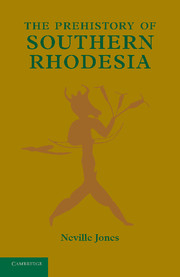Book contents
- Frontmatter
- Contents
- ILLUSTRATIONS
- Preface
- Note
- Chapter I Historical
- Chapter II The Earliest Men
- Chapter III The Building-up of the Rhodesian Sequence
- Chapter IV The Caves and Rock-shelters
- Chapter V The Rock Paintings
- Chapter VI The Ironstone Kopjes
- Conclusion
- Glossary
- References
- Index
- Miscellaneous Endmatter
Chapter IV - The Caves and Rock-shelters
Published online by Cambridge University Press: 05 June 2016
- Frontmatter
- Contents
- ILLUSTRATIONS
- Preface
- Note
- Chapter I Historical
- Chapter II The Earliest Men
- Chapter III The Building-up of the Rhodesian Sequence
- Chapter IV The Caves and Rock-shelters
- Chapter V The Rock Paintings
- Chapter VI The Ironstone Kopjes
- Conclusion
- Glossary
- References
- Index
- Miscellaneous Endmatter
Summary
A Review of the three major open sites, on which it has been possible to determine the climatic and cultural sequence in Southern Rhodesia since the human race first arrived, will show that they have provided very little detail in regard to the human occupation of the territory subsequent to the Proto- Still Bay cultural phase, with the single exception of the Magosian Culture at Sawmills which marks the end of the sequence so far as it is revealed in open sites with the backing of geological data. I should also except the sparse Wilton material found on the surface of the later alluvium discovered at Lochard, and elsewhere, but in so far as this is to all intents and purposes a superficial deposit it is of little importance. Our open-site stratigraphy carries us to a developing Middle Stone Age, and little farther.
When, however, we examine the evidence afforded by the caves and rock-shelters we are able to complete the developing sequence. The reason for this is, I think, to be found in the fact that until well into the Middle Stone Age men lived in the open, but as they advanced culturally they began to seek the permanent protection afforded them by nature in the form of caves and shelters, such as abound in our granite areas. They probably also constructed for themselves rude shelters on the veld, but of these we have no evidence. It is certainly significant that no cultural remains older than those of the Proto- Still Bay have been found in any of the excavations so far made in caves.
Of these caves, of which there are a great number, only a few are likely to yield data of value and this for the reason that very many of them contain no cultural accumulations of appreciable depth. Some of them have a bare rock floor, and any material that may have been deposited there by their original occupants has long ago been washed away. This applies particularly to the rock-shelters, but some of the caves are of such a nature and are so situated that much material has been naturally protected both by the shape of the cave as well as by the impossibility of its removal by natural means.
- Type
- Chapter
- Information
- The Prehistory of Southern Rhodesia , pp. 44 - 58Publisher: Cambridge University PressPrint publication year: 2013



